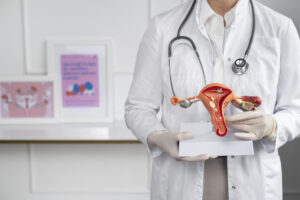So, your doctor just mentioned hysteroscopy, and now you’re spiraling through a hundred tabs, asking, “Is this safe? Will it hurt? Do I need it?”
Take a breath-you’re not alone, and you’re definitely not the only one asking these questions.
Let’s break it down together, myth-busting style, and explore why hysteroscopy is trending (yes, even in women’s health circles on Reddit), what the real benefits and risks of hysteroscopy are, and what you should consider before going in.
What Exactly Is a Hysteroscopy?
If you’re picturing something scary involving scopes and high-tech tools, you’re… not entirely wrong. But it’s actually much less dramatic than it sounds.
In a hysteroscopy, your doctor inserts a thin, lighted tube through your cervix to examine the inside of your uterus. It can be diagnostic (just looking) or operative (removing polyps, fibroids, or adhesions while they’re in there). And no, it doesn’t involve cutting you open.
This procedure is often recommended if you have:
- Heavy periods
- Recurrent miscarriages
- Fertility issues
- Suspicious ultrasound results
And here’s the kicker: it’s become much more common and safer over the past decade. So much so, it’s almost a routine tool in many gynaecology clinics.
So… Is It Safe?
Short answer: Yes, it’s considered very safe.
Longer answer? Well, like any medical procedure, it’s not totally risk-free. But statistically, complications are rare.
According to the American College of Obstetricians and Gynecologists (ACOG), serious complications from hysteroscopy occur in less than 1% of cases. That includes things like infection, bleeding, or injury to the uterus.
Most women walk out of the clinic the same day with mild cramping-less “hospital drama” and more “I-just-need-a-Netflix-day” vibes.
Why Is Everyone Talking About Hysteroscopy Now?
Here’s where it gets interesting.
You might’ve noticed a spike in awareness around hysteroscopy recently. A mix of factors is driving this trend:
- Increased IVF and fertility awareness: Many women are undergoing fertility evaluations, and hysteroscopy is one of the frontline tools to diagnose issues like uterine polyps or scar tissue.
- Better tech = safer procedures: Clinics now use advanced scopes and sedation options, which means less discomfort and higher accuracy.
- Online forums and real talk: Women are opening up more about their reproductive health journeys on platforms like BabyCenter, Reddit, and Instagram reels—and hysteroscopy is a regular topic.
Real talk: There are entire threads with women saying things like:
“I was terrified before, but it was over in 10 minutes. Felt like a bad period cramp. Totally worth it to get answers.”
Or
“Honestly? The idea was scarier than the reality. Don’t Google at midnight like I did.”
The Benefits: Why It Might Be Totally Worth It for You
Let’s look at the upsides:
Pinpoint Diagnosis: It’s one of the most accurate ways to find out what’s going on inside your uterus.
Dual Purpose: Your doctor can diagnose and treat in one go-no multiple appointments.
Minimally Invasive: No cuts, no stitches, faster recovery.
Supports Fertility Goals: Especially useful if you’re planning IVF or struggling to conceive.
In short, it’s like getting real answers instead of months of guesswork.
The Risks (and How to Be Smart About Them)
Okay, now for the not-so-fun but necessary part.
Cramping or bleeding after the procedure (usually mild)
Risk of infection (low, but take those antibiotics if prescribed)
Uterine perforation (extremely rare, especially with experienced doctors)
Pro tip: Always ask about your doctor’s experience with hysteroscopies. At top clinics like AdvaMed in Zirakpur, for example, procedures are done under the care of specialists like Dr. Nupur Sharma, who ensure safety protocols and patient comfort are the top priorities.
Still Feeling Nervous? You’re Not Alone
Here’s something honest: no matter how many stats I throw at you, it’s normal to feel anxious.
We get it-you’re not just a number in a medical journal.
You’re wondering:
- Will it hurt?
- Will it fix the problem?
- Is it really necessary?
That’s where a real conversation with your doctor comes in. They’ll assess whether you even need a hysteroscopy or if other options make more sense first.
What’s Still Unclear? And What Might Change in the Future?
The good news: newer techniques like office hysteroscopy without anesthesia are gaining traction, and AI-assisted imaging might soon make diagnoses even faster.
The not-so-clear part? We still need more research around post-procedure fertility outcomes for specific conditions like Asherman’s syndrome or chronic endometritis. But the data is growing-and that’s promising.
Final Takeaway: Educate Yourself, But Don’t Scare Yourself
Hysteroscopy isn’t a punishment-it’s a powerful diagnostic tool that helps you get real answers. The internet will always have horror stories, but it’s also full of success stories. The key? Knowing when to ask questions, who to trust, and not letting fear stop you from getting care.
And hey, if you’re considering a hysteroscopy and want expert guidance, clinics like AdvaMed are just a consult away.











